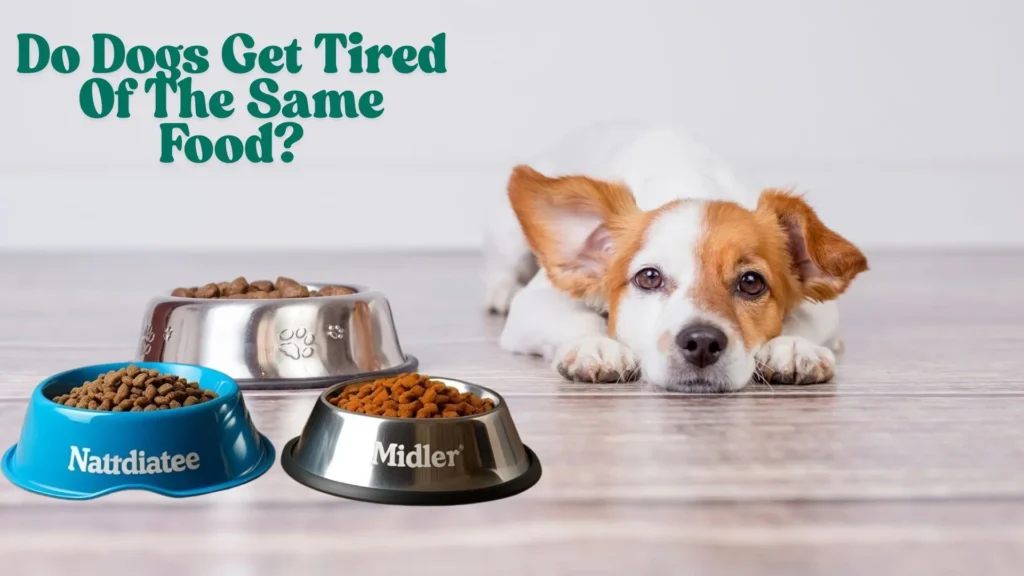As loving dog owners, we want to provide the best care possible for our furry friends, and that includes their diet. One question that often arises is, “do dogs get tired of the same food?”
It’s easy to assume they might, especially when we think about how humans crave variety. But dogs aren’t humans, and their preferences and nutritional needs are quite different.
In this ultimate guide, I’ll explore whether dogs experience food boredom, how their sense of taste and smell influences their eating habits, and when it might be time to consider changing their diet.
I’ll also look at the pros and cons of rotating dog foods and how to do it safely.
Understanding A Dog’s Sense Of Taste And Smell
To understand whether dogs get tired of their food, it helps to first understand how they experience it. Dogs have a significantly different sensory experience than humans.
For instance, while humans have around 9,000 taste buds, dogs have only about 1,700. This means their sense of taste is not as developed as ours.
However, what dogs lack in taste, they make up for in smell. A dog’s sense of smell is estimated to be 10,000 to 100,000 times more sensitive than that of humans.
Because of this, dogs rely far more on their sense of smell than taste when it comes to food. This is why even if their kibble tastes the same, they may respond more to its smell or texture.
Do Dogs Get Tired Of The Same Food?
No, dogs typically don’t get bored of eating the same food like humans might. Their sense of taste is far less developed, with fewer taste buds and a simpler palate, so they don’t crave variety in the same way we do.
While they may enjoy new scents or flavors from time to time, they’re generally content with a consistent, balanced diet that meets their nutritional needs.
Why Has My Dog Stopped Eating Their Food?
If your dog has stopped eating their food, there could be several reasons. It might be due to a change in their routine, such as a new environment or stress.
Health issues like dental problems, digestive issues, or infections can also cause a loss of appetite. Additionally, your dog could be bored with their food, or they may simply not like the current flavor or texture.
Other factors like a recent change in temperature or the presence of a new food in their diet can also affect their eating habits. If the issue persists, it’s best to consult your vet to rule out any underlying health concerns.

Do Dogs Crave Variety?
Yes, dogs can crave variety, particularly when it comes to food and activities. Just like humans, dogs may get bored with the same routine or meal every day.
Introducing new toys, different treats, or exploring new places can keep them mentally and physically engaged.
However, it’s important to balance variety with consistency, as too much change can lead to digestive issues or stress for some dogs.
How To Tell If Your Dog Is Bored With Their Food?
➤ Leaving Food Uneaten: If your dog consistently leaves their food in the bowl or only picks at it, they might be tired of the same flavor or texture.
➤ Lack of Excitement at Mealtime: Dogs usually get excited when it’s time to eat. If they’re no longer showing enthusiasm or wagging their tail when you prepare their food, it could indicate boredom.
➤ Sniffing But Not Eating: If your dog sniffs the food but then walks away or ignores it, they might not be interested in their current meal anymore.
➤ Picky Eating Habits: A dog who suddenly becomes more selective about what they eat or refuses to finish their meals could be signaling that they’re tired of the same dish.
➤ Increased Interest in Other Foods: If your dog seems overly interested in your food or starts scavenging for other food sources, it could be a sign they’re bored with their regular diet.
Can Dogs Tell The Difference Between Different Types Of Food?
Yes, dogs can tell the difference between different types of food. Their sense of smell is incredibly strong, so they can easily detect variations in aroma, flavor, and texture.
While they might not have the same taste preferences as humans, dogs can differentiate between wet and dry food, different meats, and even various flavors or spices (though some spices can be harmful to them).
Their reactions to different foods can show whether they like or dislike a particular type, making them quite discerning when it comes to what they eat.
What Do I Do If My Dog Is Bored Of Their Food?
If your dog is bored of their food, there are several things you can try to reinvigorate their interest:
✔ Switch Up the Flavor: Try offering different flavors or protein sources (like chicken, beef, or lamb) to keep things exciting. Look for high-quality dog foods with varied ingredients.
✔ Add Toppings or Mix-Ins: Adding a bit of wet food, broth (low sodium), or dog-safe veggies like carrots or sweet potatoes can make the meal more appealing.
✔ Use Food Puzzles or Slow Feeders: Introducing puzzle feeders or slow feeders can engage your dog mentally and make mealtime more interesting.
✔ Change the Routine: Sometimes, a change in feeding schedule or location can help. Try offering meals in a different area or at a different time of day.
✔ Rotate Foods: If you’re using dry kibble, consider rotating between different brands or types of food every few weeks to provide variety.
✔ Consult Your Vet: If your dog’s disinterest in food persists, it’s worth consulting your vet. It could be a sign of an underlying health issue.
When Should You Change Your Dog’s Food?
You should consider changing your dog’s food if they show signs of boredom, develop food sensitivities, or if their nutritional needs change as they age.
For example, puppies may need a different formula than adult dogs, and seniors may require food tailored for their health needs.
You might also switch if your dog’s current food isn’t providing the expected benefits, like a shiny coat or healthy digestion.
Always transition gradually over 7-10 days to avoid digestive upset and consult your vet if you’re unsure about the best time to change.
How Can I Switch My Dog’s Food?
To switch your dog’s food, do so gradually over 7-10 days to avoid digestive issues. Start by mixing a small amount of the new food with their current food, and gradually increase the proportion of the new food while decreasing the old food.
This slow transition helps your dog’s digestive system adjust and minimizes the risk of upset stomach or diarrhea.
Make sure to monitor your dog for any signs of discomfort or allergies during the switch, and consult your vet if needed.
Pros And Cons Of Changing Dog Food Frequently
Pros:
- Mental Stimulation: Just like toys or walks in new areas, new flavors and textures can keep your dog engaged.
- Broader Nutrition: If done correctly, rotating food can expose dogs to a wider range of nutrients.
- Allergy Management: Switching proteins and ingredients periodically may help reduce the risk of developing food sensitivities.
Cons:
- Digestive Upset: Dogs have sensitive stomachs, and sudden changes in diet can lead to diarrhea or vomiting.
- Pickiness: If food is changed too frequently or used to reward picky behavior, dogs may become overly selective or refuse to eat.
- Imbalanced Diets: If not managed properly, rotating between foods can lead to nutritional imbalances.
Final Thoughts
While dogs don’t have the same emotional attachment to variety as humans do, they can show signs of boredom or disinterest in their food especially if other elements like health or environment are affecting their appetite.
For most healthy dogs, eating the same balanced diet every day is perfectly fine. However, occasional variety, whether through food toppers, different feeding methods, or rotational diets, can add enrichment to their lives.
As always, the best approach is one that considers your individual dog’s needs, health, and preferences and when in doubt, consult your veterinarian.

Hello dog lovers, I am John. Welcome to my website healthydogfoods.com. I am happy to gain experience from my love for my dog and my pet dog. Through my experience and acquaintance with dog veterinarians, I have made myself a proper guide for dogs. I will tell you about dog care, their nutritious food, their proper safety and dog upbringing for a better life. Even though dogs cannot talk like humans, I will solve all the problems by observing their behavior. I will discuss the proper care and related issues of your dog. Which will give you the right answer to all the problems of your beloved dog.